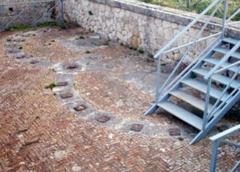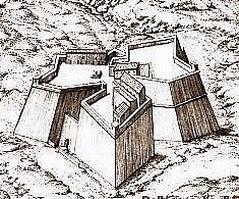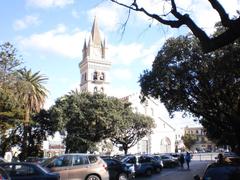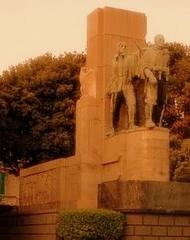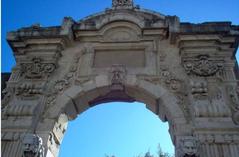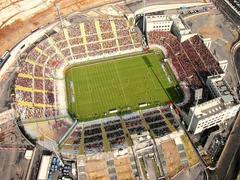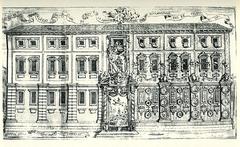
Church of the Santissima Annunziata dei Catalani Messina: Visiting Hours, Tickets, and Historical Significance
Introduction
The Church of the Santissima Annunziata dei Catalani stands as a crowning jewel in the heart of Messina, Sicily—a living testament to the island’s layered past. With foundations that reach back to an ancient Greek temple and successive transformations through Arab, Norman, and Catalan stewardship, this church is a vivid emblem of the cultural crossroads that defines Sicily. Its unique blend of Norman, Byzantine, Arab, and Romanesque architectural styles, coupled with centuries of artistic and religious heritage, makes it an essential stop for history lovers, architecture enthusiasts, and curious travelers alike (renatoprosciutto.com; discovermessina.it; wikipedia).
Location and Accessibility
Centrally located on Via Garibaldi, just steps from Piazza Duomo and Messina’s bustling port, the church is easily reached on foot—especially convenient for cruise passengers and day-trippers (traveltoitalyguide.com). The surrounding area is pedestrian-friendly, with other notable attractions such as the Messina Cathedral and Fontana di Orione within easy reach.
Address: Via Garibaldi, 111, 98122 Messina ME, Italy
Phone: +39 090 6684111 (frommers.com)
Accessibility: Due to its partially sunken floor and historic nature, access for those with mobility challenges is limited. There are steps at the entrance and no ramps or elevators.
Visiting Hours and Admission
Opening Hours:
Note: Hours may vary due to religious services, university events (as the church serves as the University of Messina’s chapel), or restoration work. Always confirm locally or via the Messina tourism office before your visit.
Admission: Free of charge. No tickets are required (frommers.com).
Historical Overview
Origins and Evolution
The site of the church originally hosted a Greek temple dedicated to Neptune, reflecting Messina’s ancient maritime significance. With the arrival of the Arabs in the 9th century, the temple was converted into a mosque, only to be reclaimed as a Christian church after the Norman conquest in the 12th century (discovermessina.it; wikipedia). The present building, completed between the mid-12th and early 13th centuries, is a rare and harmonious fusion of the architectural vocabularies of the Mediterranean.
In the late 15th century, the church became associated with the Catalan community, merchants and officials from the Crown of Aragon, who left a lasting mark on the city’s economic and civic life. This connection is memorialized in the church’s name and in its legacy as a focal point for Messina’s diverse communities (renatoprosciutto.com).
Architectural Highlights
- Exterior: The western façade is notable for its trio of 13th-century portals, including marble jambs inlaid with Arabic inscriptions. The church’s sunken aspect—caused by the catastrophic 1908 earthquake that raised the street level by about three meters—adds to its visual intrigue (enjoysicilia.it).
- Structural Plan: A basilica with a nave and two aisles separated by stone and brick columns, crowned with a dome in the Byzantine tradition. Decorative motifs and geometric patterns reflect Arab and Norman influences (thecrazytourist.com).
- Interior: The sanctuary features Corinthian columns, sun-dappled stonework, and an austere yet harmonious atmosphere. The apse is a masterpiece of Norman composite style, and the dome’s transition from square to circular is achieved with Byzantine pendentives (pineqone.com).
Artistic Treasures
- Wooden Crucifix: A 15th-century wooden crucifix, lost during the 1908 earthquake and rediscovered in the late 20th century, stands as a testament to Messina’s artistic heritage (renatoprosciutto.com).
- Altarpiece by Tommaso Montella: The “Immacolata” (1606) is among the notable works once housed here.
- Statue of Don Juan of Austria: Carved by Andrea Calamech in 1572, this striking statue at the rear of the church celebrates Don Juan’s victory at the Battle of Lepanto and offers a dramatic historical vignette (frommers.com).
Visitor Tips and Recommendations
- Best Time to Visit: Early mornings offer the quietest atmosphere and ideal lighting for photography (offthetouristtreadmill.com).
- Photography: Permitted, but be discreet during services or events. The best exterior shots can be taken from the western façade.
- Language: Most signage is in Italian, with some English translations. Having a translation app may be helpful.
- Dress Code: Modest attire is recommended out of respect for the church’s religious function.
- Nearby Attractions: The Messina Cathedral, Fontana di Orione, Fontana di Nettuno, and the Regional Museum are all within easy walking distance (traveltoitalyguide.com).
Special Events and Services
As the chapel for the University of Messina, the church may occasionally close for private events or ceremonies (offthetouristtreadmill.com). It is not a parish church with regular public Masses, but special services may be held—check in advance if you wish to attend or avoid such events.
Notable Visuals
View the church on the map to plan your visit.
Frequently Asked Questions (FAQ)
What are the visiting hours for the Church of the Santissima Annunziata dei Catalani?
Monday to Saturday: 9:30 am–11:30 am; Sunday: 9:00 am–11:30 am. Always verify before visiting.
Is there an admission fee?
No, admission is free.
Are guided tours available?
Walking tours of Messina often include the church; no regular tours are offered onsite.
Is the church wheelchair accessible?
Due to steps and uneven pavement, accessibility is limited.
Can I take photographs?
Yes, but be discreet and avoid flash during services.
Call to Action
Plan your visit to the Church of the Santissima Annunziata dei Catalani and immerse yourself in the rich tapestry of Messina’s history. For the latest updates on opening hours and special events, download the Audiala app and consult the official Messina tourism website. Explore more of Messina’s treasures with our Historic Center Guide and Top Historical Sites in Sicily.
Summary
The Church of the Santissima Annunziata dei Catalani is more than just an architectural marvel; it embodies the enduring spirit of Messina’s multicultural past. From its ancient Greek origins and Arab-Norman synthesis to its Catalan legacy and artistic treasures, the church invites visitors to experience the resilience and diversity of Sicilian history. With free entry, central location, and proximity to other key sites, it is a must for anyone exploring Messina. Plan ahead, enjoy the art and atmosphere, and connect with the centuries-old stories embedded in its walls (renatoprosciutto.com; discovermessina.it; Lonely Planet).
References
- Santissima Annunziata dei Catalani in Messina: History, Architecture, and Visitor Information, 2025, Renato Prosciutto
- Santissima Annunziata dei Catalani: Visiting Hours, Tickets & History of Messina’s Iconic Church, 2025, Discover Messina
- Santissima Annunziata dei Catalani, Wikipedia Italy, 2025
- Church of the Santissima Annunziata dei Catalani Visiting Hours, Tickets, and Historical Guide in Messina, 2025, Frommers
- Santissima Annunziata dei Catalani, Lonely Planet, 2025
- 15 Best Things to Do in Messina, The Crazy Tourist, 2025








